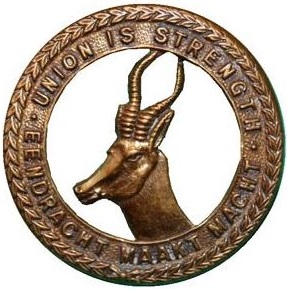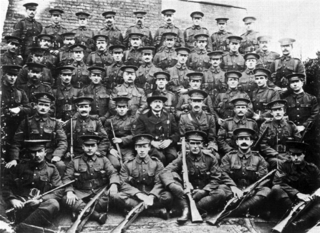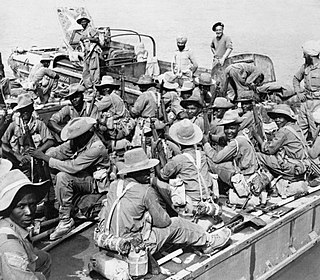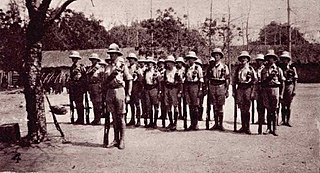

The Carrier Corps was a labour corps created in Kenya during the First World War to provide military labour to support the British campaign against the German Army in East Africa.


The Carrier Corps was a labour corps created in Kenya during the First World War to provide military labour to support the British campaign against the German Army in East Africa.
Whereas the Germans, commanded by Paul von Lettow-Vorbeck, armed and trained African askaris to create an effective guerrilla force able to live off the land; the British attempted to deploy Indian Army troops under Jan Smuts and keep the King's African Rifles as internal security troops, with limited success. Not only were the Indian Army unused to the terrain, the need to feed a large body of foreign soldiers presented severe logistical problems, as troops in the interior had to be supplied over long distances without rail or road lines of communication. To deliver one kilogram of rice to the interior it could take 50 kilograms of rice at the coast—most of it being consumed en route to feed all the porters needed to carry it inland. The British Administration formed a military labour organisation, the Carrier Corps, which ultimately recruited or conscripted over 400,000 African men for porterage and other support tasks.
The effect on many of the native East African population, then still largely tribal, of being mobilised and then enduring considerable hardship for a remote and largely irrelevant foreign cause had significant effects in the long term, both highlighting the fallibility of the European presence in Africa (as armed askaris readily killed white men), and raising the political awareness of Africans as to the need to stand up for their own interests. The organisation of the Carrier Corps was a remarkable feat of improvisation by a small number of officials of the East African Protectorate's administration, under a District Commissioner Lt Col Oscar Ferris Watkins. Watkins and his officials faced a constant struggle against his superior's excessive demands upon the Carriers and to conscript further native manpower.
The Carrier Corps is commemorated on the War Memorials in Kenyatta Avenue, Nairobi and Jomo Kenyatta Avenue, Mombasa. The 14,000 men of the Northern Rhodesian contingent of the Carrier Corps are commemorated on the Mbala War Memorial at the entrance to the town of Mbala (formerly Abercorn) in Northern Zambia. They came from across the territory, with a large contingent from what was then Barotseland in North-Western Rhodesia. The Barotse were recruited by the British South Africa Company Native Commissioner, John Henry Venning, who marched with them to the East African border.
Several East African towns have quarters named after the carrier corps presumably because members of the corps were given housing in these places. Such quarters include Kariakor in Nairobi, Kariakor in Voi, Kariakoo in Dar es Salaam and also in Dodoma.

A part of Eastern Africa, the territory of what is known as Kenya has seen human habitation since the beginning of the Lower Paleolithic. The Bantu expansion from a West African centre of dispersal reached the area by the 1st millennium AD. With the borders of the modern state at the crossroads of the Bantu, Nilo-Saharan and Afro-Asiatic ethno-linguistic areas of Africa, Kenya is a multi-ethnic state. The Wanga Kingdom was formally established in the late 17th century. The Kingdom covered from the Jinja in Uganda to Naivasha in the East of Kenya. This is the first time the Wanga people and Luhya tribe were united and led by a centralized leader, a king, known as the Nabongo.

The King's African Rifles (KAR) was a British Colonial Auxiliary Forces regiment raised from Britain's East African colonies in 1902. It primarily carried out internal security duties within these colonies along with military service elsewhere during the world wars and other conflicts, such as the Malayan Emergency and the Mau Mau uprising. The regiment's enlisted soldiers were drawn from the native Africans, while most officers were seconded from the British Army. During the 1960s, as part of the decolonisation of Africa, more African officers were commissioned into the regiment before it was gradually disbanded. KAR battalions would go on to form the core of newly established armed forces throughout East Africa.

An askari or ascari was a local soldier serving in the armies of the European colonial powers in Africa, particularly in the African Great Lakes, Northeast Africa and Central Africa. The word is used in this sense in English, as well as in German, Italian, Urdu, and Portuguese. In French, the word is used only in reference to native troops outside the French colonial empire. The designation is still in occasional use today to informally describe police, gendarmerie and security guards.

Schutztruppe was the official name of the colonial troops in the African territories of the German colonial empire from the late 19th century to 1918. Similar to other colonial armies, the Schutztruppen consisted of volunteer European commissioned and non-commissioned officers, medical and veterinary officers. Most enlisted ranks were recruited from indigenous communities within the German colonies or from elsewhere in Africa.

East Africa Protectorate was a British protectorate in the African Great Lakes, occupying roughly the same area as present-day Kenya, from the Indian Ocean inland to the border with Uganda in the west. Controlled by the United Kingdom in the late 19th century, it grew out of British commercial interests in the area in the 1880s and remained a protectorate until 1920 when it became the Colony of Kenya, save for an independent 16-kilometre-wide (10 mi) coastal strip that became the Kenya Protectorate.

The East African campaign in World War I was a series of battles and guerrilla actions, which started in German East Africa (GEA) and spread to portions of Mozambique, Rhodesia, British East Africa, the Uganda, and the Belgian Congo. The campaign all but ended in German East Africa in November 1917 when the Germans entered Mozambique and continued the campaign living off Portuguese supplies.

The South African Overseas Expeditionary Force (SAOEF) was a volunteer military organisation in World War I.
John William Arthur was a medical missionary and Church of Scotland minister who served in British East Africa (Kenya) from 1907 to 1937. He was known simply as Doctor Arthur to generations of Africans.
Lt Col Oscar Ferris Watkins CMG CBE DSO (1877–1943) was a British colonial administrator, Commandant of the East African Carrier Corps in the First World War. After the war he was acting Kenya Chief Native Commissioner and a Provincial Commissioner, and first editor of a Swahili newspaper Baraza.
The Kapenguria Six – Bildad Kaggia, Kung'u Karumba, Jomo Kenyatta, Fred Kubai, Paul Ngei, and Achieng' Oneko – were six leading Kenyan nationalists who were arrested in 1952, tried at Kapenguria in 1952–53, and imprisoned thereafter in Northern Kenya.

Indians in Kenya, often known as Kenyan Asians, are citizens and residents of Kenya with ancestral roots in the Indian subcontinent. Significant Indian migration to modern-day Kenya began following the creation of the British East Africa Protectorate in 1895, which had strong infrastructure links with Bombay in British India. Indians in Kenya predominantly live in the major urban areas of Nairobi and Mombasa, with a minority living in rural areas.
June Knowles, better known by her pen name Elizabeth Watkins, was an English author, brought up in Kenya, where her parents - Oscar Ferris Watkins (1877–1943) and Olga Florence Watkins (1889–1947) - had started a coffee farm outside Nairobi, and later educated at St Anne's College, Oxford.

The Colony and Protectorate of Kenya, commonly known as British Kenya or British East Africa, was part of the British Empire in Africa from 1920 until 1963. It was established when the former East Africa Protectorate was transformed into a British Crown colony in 1920. Technically, the "Colony of Kenya" referred to the interior lands, while a 16 km (10 mi) coastal strip, nominally on lease from the Sultan of Zanzibar, was the "Protectorate of Kenya", but the two were controlled as a single administrative unit. The colony came to an end in 1963 when an ethnic Kenyan majority government was elected for the first time and eventually declared independence.

The Kenya Army is the land arm of the Kenya Defence Forces.
The following is a timeline of the history of the city of Nairobi, Kenya.

When the United Kingdom declared war on Germany at the start of World War I in August 1914, settler society in Southern Rhodesia, then administered by the British South Africa Company, received the news with great patriotic enthusiasm. The Company administrator, Sir William Milton, wired the UK government, "All Rhodesia ... ready to do its duty". Although it supported Britain, the company was concerned about the possible financial implications for its chartered territory should it make direct commitments to the war effort, particularly at first, so most of the colony's contribution to the war was made by Southern Rhodesians individually—not only those who volunteered to fight abroad, but also those who remained at home and raised funds to donate food, equipment and other supplies.

The involvement of the Nyasaland Protectorate in World War II began with the declaration of war on Nazi Germany by the British Empire in September 1939. Though no combat occurred in Nyasaland itself, it remained an economic asset for the Allies and also contributed a significant number of soldiers to fight in the British Army.

The South African Native Labour Corps (SANLC) was a force of workers formed in 1916 in response to a British request for workers at French ports. About 25,000 South Africans joined the Corps. The SANLC was utilized in various menial noncombat tasks. The SANLC was disbanded by the South African government in January 1918.

Brigadier general William Frederick Savery Edwards (1872–1941), commonly referred to as Brigadier-General W. F. S. Edwards, was a decorated British military officer who was appointed by the British Colonial Administration as the first Inspector General of the Uganda Protectorate Police, which later became the Uganda Police, and the simultaneous overall commander of the then British East Africa Police.

The Nyasaland Volunteer Reserve (NVR) was a British Colonial Auxiliary Forces unit raised in the British protectorate of Nyasaland. The British Central Africa Volunteer Reserve was formally established by the colonial government in 1901 and was renamed when the protectorate became Nyasaland in 1907. In the initial years the unit was little more than a rifle shooting club with no uniform and no military training. The NVR was placed on a more formal standing in 1908 under the Volunteer Ordinance. This implemented residency and racial requirements for membership and made provision for the unit to be mobilised by the governor. The unit was initially formed of four sections but grew to seven sections by 1914 and by 1930 the unit had ten.
This article includes a list of references, related reading, or external links, but its sources remain unclear because it lacks inline citations .(March 2014) |